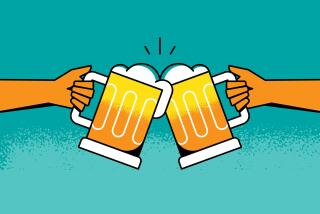CLUB OWNER IS TRUE TO THE SPIRIT OF MUSIC
- Share via
SAN DIEGO — Jerry Herrera is a tough old prospector whose intuition told him to stake out his claim early.
Six years ago, when San Diego’s new wave scene was just beginning to sparkle, Herrera was one of the first local club owners to react.
Very quickly, he booted out the Top 40 dance bands that had been appearing at the Spirit since he opened the Bay Park nightclub in 1975.
He replaced them with an eclectic mix of national and local new wave bands that played only their own music.
When the rush hit, Herrera struck it rich. Lines formed around the block to see such national acts as X and the Plimsouls, as well as local favorites like the Penetrators, DFX2, and the Rick Elias Band.
The Spirit, Herrera recalled proudly, was “the center for new wave activity in all of San Diego.”
Two years later, the boom fizzled. Most of the other club owners either went back to Top 40 bands, or tossed out live music entirely in favor of the pulsating beat of disco records.
Not Herrera. The Spirit is still a haven for original rock ‘n’ roll.
Among the national bands that have played there recently are the hard-core punkers Circle Jerks and Black Flag, more moderate new wavers like Stan Ridgeway and the Lords of the New Church, and the Jamaican reggae bands, the Mighty Diamonds and Mutuburuka.
Local bookings include appearances by new wavers Playground Slap and the Seventh, blues singer Tom ‘Cat’ Courtney, and heavy metalists Assassin, Chalice, and Prowler.
And though attendance at the Spirit is nowhere near what it was in the peak years of 1980 and 1981, Herrera isn’t about to relinquish his claim.
His intuition, you see, tells him the mother lode of original talent is not yet depleted.
“The scene originally died because of disco and MTV,” said Herrera, 43. “San Diego has always been very trend-conscious, and when disco came back big all over the country several years ago, people no longer wanted to go out and listen to music--all they wanted to do was dance.
“Then along came MTV, and that delivered the second blow to original music. MTV mainstreamed everything, and once everything gets mainstreamed, it’s no longer unique and different.
“Before, people had to come to clubs like the Spirit to see new music; with MTV, all they had to do was turn on their television sets.
“But little by little, that’s changing again. I think people are growing tired of discos; they’re growing tired of just watching bands on TV instead of seeing them perform live.
“And that’s why I’m convinced live rock is coming back, and I want to be here when it does.”
A native San Diegan, Herrera began his career in music by booking bands in the late 1950s and early ‘60s for dances and concerts. He worked with local talent as well as nationals like the Coasters, the Kingsmen, Them, and Sonny and Cher.
In 1965, Herrera opened San Diego’s first rock ‘n’ roll nightclub, the Palace, across the street from the San Diego Sports Arena. His bookings ran the gamut from soul to acid rock; for a while, he recalled, the house band was the Palace Pages, which later moved to Los Angeles and changed its name to Iron Butterfly.
Eight years later, Herrera teamed up with veteran local concert promoter James Pagni to start a new club, J.J.’s, on Pacific Highway.
He began working with more and more national talent, including Steely Dan, Foghat, ZZ Top, Jesse Colin Young, and the Electric Light Orchestra.
Lease problems forced the closure of J.J.’s in 1975, Herrera said, but within a few months he was back in business at the Spirit.
For the first few years, Herrera recalled, he experimented with first Latin and then Top 40 dance bands. On a lark, he switched to original new wave in March of 1980--and before long, Herrera and the Spirit were on a roll.
Over the years, Herrera has had his share of problems in dealing with original bands. Several local groups have boycotted the Spirit because they claim Herrera doesn’t pay them enough, and he has also been at odds with the local Musicians Union because he refuses to pay union scale.
But Herrera is unmoved. He maintains that his policy of paying bands a percentage of the gate is fair, “because that encourages them to promote their shows themselves, and besides, that’s about all I can afford.”
He added that he “could probably make a lot more money” if he turned the Spirit into a disco, or at least returned to Top 40 dance bands, but he insists that will never happen.
“I guess I’m a fool,” he said, laughing, “but the thing that has kept me going for all these years is that I really love original rock ‘n’ roll.
“I like seeing things created. I like seeing bands play music they write themselves, instead of the same old Top 40 tunes you hear every day on the radio.
“Sure, I could probably make a lot more money if I would change, but I would be very unhappy--and I don’t want to be unhappy.
“So if I can keep on featuring original music and make enough bucks to get by, that’s fine. But I’m sure things will improve. Everything goes in cycles, and the time for original rock is coming back.”
More to Read
The biggest entertainment stories
Get our big stories about Hollywood, film, television, music, arts, culture and more right in your inbox as soon as they publish.
You may occasionally receive promotional content from the Los Angeles Times.










